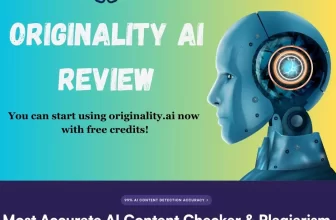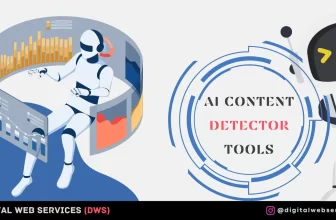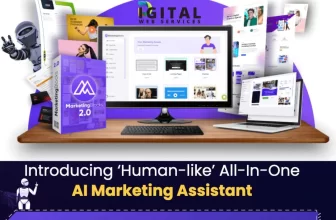
Can a computer mimic human intelligence and be as creative?
For the longest time, AI programs have only worked by the data that we fed to them.
But now with machine learning enabling algorithms to develop beyond the code, artists may start to feel threatened as art-producing programs gain the ability to improve from past mistakes.
For example, an AI screenwriter program, self-named Benjamin, has been making headlines for crafting screenplays, which are rather okay by industry standards.
But does that mean you should be worried about AI taking your job?
Well, that doesn’t seem to be happening anytime soon.
Many AI-powered tools have so far worked to complement artists rather than take the driver’s seat.
AI is more often than not being put to work to handle repetitive, uncreative chores that take up a lot of an artist’s valuable time.
In this article, we’ll be discussing the impact of artificial intelligence on art and artists, and how AI tools are helping creatives rather than replacing them.
Let’s get started.
1. Graphic Design Convenience
What software package do you use for design groundwork?
The modern-day artist relies on cutting-edge graphic design tools to create masterpieces, one of the most popular options being Adobe’s suite of services.
Using the software’s AI-powered features, it’s possible to speed through basic groundwork and skip straight to the heart of the design.
Based on past works within the Adobe Suite, it’s machine learning features learn about your habits and preferences.
From this data, the AI-driven algorithm suggests certain design accents like video frames, which are implementable by a single click. There are also options of similar convenience when it comes to coloring complete line arts in one motion.
For an even bigger head start, Celsys’ Clip Studio is taking coloring to another level with its AI-facilitated auto coloring feature.
The software adds meat to simple line drawings, turning rudimentary sketches to complete drawings.
Human intervention is still necessary though, because of unpredictable results, which often need some manual finetuning. This may seem like cheating, but you can save loads of time.
If you’re juggling a day job or family responsibilities, and are hard-pressed to find time to work when inspiration strikes, the above article has a couple of handy pointers on squeezing opportunities out of your routine.
2. Novel Editing Ease
For novelists, AI software also offers great plot insight and other data metrics so that authors can identify areas of improvement.
Traditionally, you’d have to wait until a considerable number of pages are out of the way before beginning any assessment.
Now, however, AI-powered tools can offer an eye-of-God perspective over the course of the project. Red flags are identified early on before handing over the work to a professional editing team.
For example, AI software such as Marlowe, named after the English playwright, can edit and critique long works of fiction to point out discrepancies.
Marlowe can single out problems with character development, and narrative arcs.
Additionally, Marlowe can also establish the reading level of your work, through syntax and grammar analysis made possible by natural language processing.
Furthermore, it offers yardsticks of success in your genre in the way of successful past works. It becomes easy as well to craft better dialogues from Marlowe’s suggestions.
Generally speaking though, AI-driven self-editing tools are works in progress.
If you’d be interested in how intelligent assistants like Marlowe work and mastering how to use AI to fulfill your own artistic needs, this artificial intelligence course for beginners is perfect for you.
As a creative, it’s important to be aware of how the evolution of technology affects your line of work. The above AI course is an excellent source of some handy AI skills and concepts beneficial to your business.
3. Beat Composition Assistance
Do you have trouble coming up with beats for a new song?
Perhaps you’ve squeezed out all you can from your conventional music editing software and are looking for a better option. Alternatively, it could be a mental roadblock issue, where AI software excels in providing that missing spark to ignite creativity.
Let’s consider the case of Western music, for example. The genre entails minor scales, major scales, and notes totaling about 36. Additionally, factor in harmony and tempo, and you’re staring at millions of possible tune options.
With AI-powered tools, musicians can remix or create beats to build a catchy backdrop for new tracks.
What’s more, you can do this with minimal knowledge of programming languages. The algorithm does the heavy lifting to present complete soundtracks.
Via machine learning, composing software samples data sets from other successful genre songs. It then uses this data to compose new tunes.
AI-powered tools like Yona can also help sing out lyrics, or write new ones.
If you’d like to add a new collaborative voice to your track and can’t seem to find a suitable partner, Yona may be able to help. She is still a work in progress though, and her songs aren’t the best. Hence, you shouldn’t lose any sleep over getting replaced by an AI singer.
4. Instrument Learning Apps
How did you learn to play your musical tool of choice?
For the budding instrumentalist, getting good means countless practice hours, several YouTube videos, and, of course, an excellent tutor.
However, AI advancement now avails additional machine learning resources to supplement lessons by human teachers.
AI-driven music apps are offering practical lessons and providing real-time feedback from playing sessions with learners.
SimplyPiano, for example, is one of many AI-powered tools helping with basic piano mastery, including reading music sheets and playing coherent notes on an acoustic piano.
The standard piano has 88 keys. SimplyPiano uses machine learning to offer player analysis, and also to compare what key is played against what key should be played.
If you’d like to know more about how machine learning fuels apps like SimplyPiano, maybe for inspiration on how to build an AI app from scratch, this article breaks down machine learning in 7 simple steps.
With these ML tips, you’ll be better able to understand what happens under the hood of instrument learning apps.
Using an AI-powered engine, Simply Piano is able to decipher the distinct frequencies of simultaneous notes instead of general background noise in the room.
The result is a wireless piano teaching set up where you can take lessons with only your phone serving as the guide.
SimplyPiano is just one example of AI-powered apps helping artists to master a wide range of various musical instruments from flutes to guitars.
5. Intelligent Photography Aids
Photography can be one of the most beautiful forms of expression, yet challenging to master at the same time for aspiring artists.
For the inexperienced DSLR photographer, getting the right combination of ISO, shutter speed, and aperture means long periods of tweaking manual settings.
Even then, you may have to experiment with multiple photo iterations to find the “perfect shot” when moving across different scenery.
AI-powered photography assistants like Arsenal, for example, are providing photography setting insights.
Arsenal is an intelligent camera assistant, with a physical unit that mounts onto a camera.
It is powered by CNNs or Convolutional Neural Networks that learn from a database of thousands of sample photos.
Arsenal can recommend settings for your stills, drawing from the observation of the environment.
At the moment, the software is able to find optimal photography settings by learning from 18 environmental factors, including:
- Texture analysis
- Subject motion
- Sensor size and more
What’s more, this AI-driven assistant enables easy scaling up to about four times while still maintaining good image quality, even on a JPEG format.
Conclusion
Artificial intelligence is slipping into every sphere of business and life.
Does that mean artists should be concerned about AI replacements?
I think not.
From these use cases on the impact of artificial intelligence on art and artists, you’ll agree that AI serves mostly to aid human creatives as opposed to outrightly taking our jobs.
While screenwriting bots like Benjamin are effectively doing a creative’s work, they are not very good at it, hence the preference for human creativity.
Instead of worrying about how AI could replace us, it’s better to be more concerned about how technology can make us better artists.
AI is useful across various artistic niches from photography to writing, and there’s certainly a way or two different art businesses could profit from it.
Digital Web Services (DWS) is a leading IT company specializing in Software Development, Web Application Development, Website Designing, and Digital Marketing. Here are providing all kinds of services and solutions for the digital transformation of any business and website.










